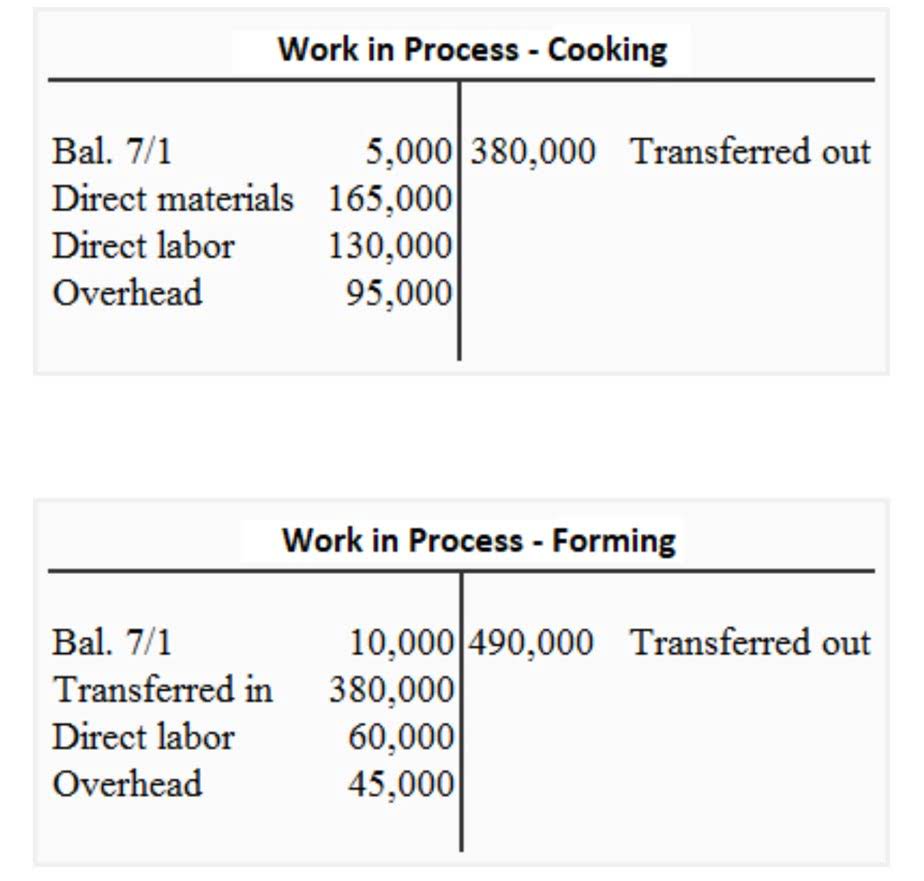
In addition to direct labor costs, indirect labor, such as maintenance staff or quality control, is accounted for in overhead. In manufacturing cost accounting, costs are classified as either direct or indirect. The direct labor Manufacturing account tracks all of the wages paid to workers directly involved in the production process. Process costing for manufacturing is generally used by manufacturers who produce standardized goods using similar or the same processes. Each customer receives identical or similar products manufactured using identical or similar processes. This accounting method tracks individual items of inventory, which is useful if you can identify each item with, for example, a serial number or RFID tag.

Overview of Manufacturing Costs and Costing Methods
- Though they’re not ready for sale, these goods are still an asset on your balance sheet.
- Accounting for manufacturing companies becomes significantly more efficient and beneficial when these best practices are followed.
- This lecture will clarify how to prepare the income statement for a manufacturing company.
- Accounting for manufacturing overhead costs requires more effort, and can be more challenging compared to other costing efforts because of the difficulty in assigning them to specific products or outcomes.
- When you’re a Pro, you’re able to pick up tax filing, consultation, and bookkeeping jobs on our platform while maintaining your flexibility.
- There are several common terms used in manufacturing accounting which can be defined to help better guide the accounting decisions and lead to a more accurate and timely calculation of total manufacturing cost.
The last-in-first-out (LIFO) inventory valuation method is the opposite of the FIFO approach. Getting expert tax and accounting advice is worthwhile for virtually every business. A Certified Public Accountant (CPA) with experience in your industry can provide valuable financial insight and ensure you meet your tax obligations. Running a manufacturing company while managing its books is a challenging prospect.
Improved Financial Planning
In addition to understanding how to calculate COGM and COGS, it’s important to familiarize yourself with inventory valuation. Lastly, sum-of-years depreciation is used to accelerate an asset’s depreciation rate. In this method, the depreciation expense is highest in the first year of the asset’s life and decreases over subsequent years. This reflects how some assets may be more productive or provide more value in their earlier years. Manufacturers must also adhere to various accounting standards and regulations, as non-compliance can lead to legal repercussions and financial penalties.
Accounting for manufacturing businesses
Depreciation is a way to financially account for the decrease in value of a physical asset over time. Having these standards allows you to detect variances that can be analyzed, allowing trends to be spotted, and enabling you to make the right adjustments to pricing. If you are spending more on manufacturing the product than necessary, you will not meet your income targets.
Labour costs
Manufacturing accounting teams can work to ensure that indirect costs are allocated appropriately and accurately. Different production costing methods discussed earlier in this article can have significant impact on how the business operates and financial results are interpreted. Determine which costing methods for manufacturing produces the most accurate calculations and the most opportunity for growth. Also consider unique situations, such as when employees purchase items for production using a company credit card. These costs must be correctly allocated to the right job or product or order, and manufacturing accounting software might be a big help.
- At the same time, crediting the profit and loss account by the amount of manufacturing profit does not affect the net profit.
- It can be more difficult to implement than standard or job costing, however, as a more detailed overview is required over the manufacturing process.
- It is sometimes difficult to manage, however, as individual tracking and allocation of costs can be time-consuming.
- Overall, accounting for manufacturing costs requires a specialized understanding of the unique aspects and complexities of the manufacturing industry.
- This includes any items used in the production process but is not yet part of the finished product.
- Manufacturing accounting is a group of inventory and production management processes used for monitoring and controlling the costs involved with manufacturing products.
- Here’s what you need to know to navigate manufacturing accounting successfully, including the best practices for the industry, the most complicated processes involved, and some fundamental terms.
Accurate manufacturing accounting ensures businesses can confidently sail through financial uncertainties, thanks to comprehensive accounting data. It provides a detailed insight into the indirect costs and total cost of manufacturing, helping companies to evaluate their profitability. This accuracy in determining the cost of producing a product is vital for strategic decision-making and maintaining healthy inventory management practices, aligning with generally accepted accounting principles. Manufacturing accountants are like the guardians of the treasure chest, ensuring no coin is wasted, epitomizing the precision and efficiency of modern manufacturing accounting.
Indirect costs are not directly connected to the production of the finished goods. Utilities, clerks, security guards, cleaning supplies, rentals, insurance, recruiters, and other costs are considered overhead. It’s critical to accurately determine direct costs and overhead costs because only direct costs are used to determine the value of inventories and gross profits. On your typical manufacturing manufacturing accounting balance sheet, you should have raw materials, work in process, and finished goods as part of your inventory calculation. You will also want a periodic or perpetual inventory system to track how many products you have in your production line at any one time. Finished goods inventory refers to the units that have made it through the production process and are ready for sale.

- A direct cost is an expense that you can easily trace to product manufacturing processes.
- This costing method is similar to job costing, however, it calculates item costs by adding together the direct costs and overheads per processing step of a product’s lifecycle, rather than per individual item or job.
- Wood is the raw material, but it must be received, processed, , and properly stored.
- There is much to learn and many decisions to make along the way, but it is a critical task for manufacturers.
- Each of these accounts represents a different step in the production process.
Manufacturing cost accounting systems then must capture the cost of manufacturing but be flexible enough for many different manufacturing methods, processes, and technique. Direct labor includes the cost of workers who transform raw materials into finished goods. The wages of the worker who assembles the tables are direct labor, but not the salary of the janitor who keeps your factory clean. This approach to production costing helps with creating and refining budgets. When you can estimate how much it’ll cost to produce each unit, you can gauge your progress during each accounting period.

Your https://www.bookstime.com/ software should also help you keep compliant with regulations and the tax laws of the countries you have a business in. Often, manufacturers invest in an all-in-one solution, which handles other tasks away from finances, such as planning and production. Ideally, data should move freely between production lines and the back office, meaning you have accurate real-time data. It’s like a detailed grocery list (bill of materials) and a careful budget (job costing), ensuring the total cost doesn’t eat into profits.
